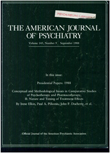High-affinity imipramine binding and serotonin uptake in platelets of eight adolescent and ten adult obsessive-compulsive patients
Abstract
The authors evaluated high-affinity [3H]imipramine binding and [3H]serotonin uptake to platelets in eight adolescent and 10 adult patients who met DSM-III criteria for obsessive-compulsive disorder in comparison with those of normal control subjects of similar ages. The maximal binding of [3H]imipramine was significantly lower in adults and adolescents with obsessive-compulsive disorder than in the control subjects. No differences between groups in the affinity of [3H]imipramine to its binding sites or in serotonin uptake kinetic measures were detected. The lower density of [3H]imipramine binding sites in platelet membrane in patients with obsessive-compulsive disorder might implicate involvement of the serotonergic system or might represent an adaptive response to a chronic disease.
Access content
To read the fulltext, please use one of the options below to sign in or purchase access.- Personal login
- Institutional Login
- Sign in via OpenAthens
- Register for access
-
Please login/register if you wish to pair your device and check access availability.
Not a subscriber?
PsychiatryOnline subscription options offer access to the DSM-5 library, books, journals, CME, and patient resources. This all-in-one virtual library provides psychiatrists and mental health professionals with key resources for diagnosis, treatment, research, and professional development.
Need more help? PsychiatryOnline Customer Service may be reached by emailing [email protected] or by calling 800-368-5777 (in the U.S.) or 703-907-7322 (outside the U.S.).



